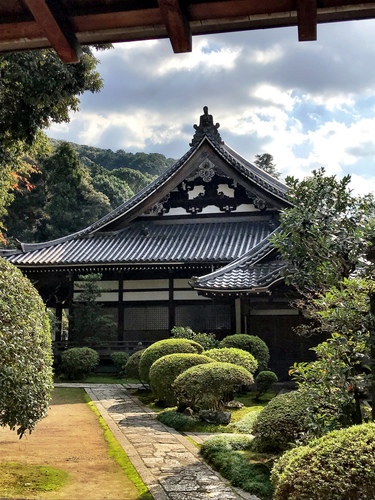Many native Japanese have learned English in school through studying textbooks and reading grammar. This is essential, but the only way to learn to understand in English is to practice your listening skills.
A great way to do this is with a simple story in English. Today, I want to share a simple story I wrote based on my year of living in Kyoto. At the bottom, I include the audio recording of me reading the story. You can listen to the sound and pronunciation of my voice while you read along.
Enjoy!

The Student and the Zen Master by Kirk Lee
In Japan there is an old Zen story of a young man who traveled the world until he made his way to the old ancient city of Kyoto. He was on a quest seeking to learn the centuries old art of archery from a truly enlightened Master. After many miles of relentless searching he found his way to a highly respected old teacher who was known in the traditional lineage of archery which was guarded and had only been passed down from Master to Master.
The young man found his way to the old wooden hut where he eagerly inquired to be his student in order to learn the secret skills traditionally only passed on to those within the lineage of Japanese culture and descent.
For many months the young man waited outside the old Master’s hut and was repeatedly refused, quietly told by the Master’s apprentice that the Master was not taking on any new disciples and did not have the time or patience in his ripe old age to train any more students, much less a “Gaijin”, the Japanese word for non-Japanese.
Because the young man had traveled such a great distance and overcome many odds to reach the Master’s humble gate, he remained outside, unwavering in his pursuit. Observing his patience and commitment to learning and mastering “the Way”, the old Master was deeply moved and decided to accept the young protege as his student. Thus began the young man’s journey under the guidance of the Master into the true art of archery and the Way to enlightenment.
During the many first of many months in his early dawn training, the Master taught the pupil only one lesson, one single step. The beginning lesson, above all others, was the most important key of all and in it contained the realization of Mastery.
The first and most important key was that there was no target “out there” and no student. The two were one in the same.
There is no target out there.
The student and target are one in the same.
The target was already realized within the student and the student was also the target. No separation. The only separation was in the mind and this separation in the mind would lead to may divergent paths away from true oneness with the goal. It was not until the disciple mastered this key first principle that he was ready to move forward and proceed with his training.
The old Master quietly demonstrated this first key principle by calmly and slowly drawing his carefully crafted bamboo bow as a butterfly might silently land on a flower. While keeping his eyes restfully closed he released the arrow as the pupil watched it soar seamlessly through the air, becoming one with the centermost point of the target.
This is where we must begin.
During the first year of his training, through many frigid cold mornings in the dark and into the rainy season of Japan, the young novice failed miserably, day after day. His internal frustration grew, met only by his deeper resolve to learn “the Way” and reach the goal of Mastery and excellence. The wise old Master watched quietly, sipping his hot tea, some days tending to his garden while the young man repeated the steps over and over, yet made no progress.
“It is not in your technique or practice that the problem lies, but in your inability to see. You must first see the target as already reached. You must see yourself and the target as already realized.”
The young man pondered and meditated on this for many days and weeks. He would wake up early in the morning and sit. He began to focus less on the techniques he was practicing and simply took time each morning before his practice to sit quietly and see the goal as already achieved. He began to get glimpses of himself and the target as one in the same. In his mind the two began to merge as one and he found himself to be more peaceful in his practice of the techniques he had already begun to know.
“Master, there are moments when I can see the target as already penetrated by the arrow and there is no distance or separation between myself and the target. We are simply one in the same. But then on other days I lose my concentration an my thoughts take me into all of the ways I should be doing the practice and the arrow flies astray.”
“Keep focusing and repeating each morning before you begin with your eyes closed”, said the old Master. “It is in the seeing that you already have achieved the outcome. The techniques and the practices will naturally follow and become secondary once the goal has been seen and achieved in your mind’s eye.”
The young protege continued this simple practice for many months, every day, early each morning before arriving for his lesson.
After the first year, with no focus on any other techniques or practices, something magical began to occur.....
He and the target became one.
Listen: https://drive.google.com/file/d/19WUj8mz449vq7x4ObjmbRKwpr5Em21uo/view?usp=sharing




回應 (0)